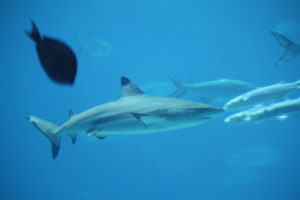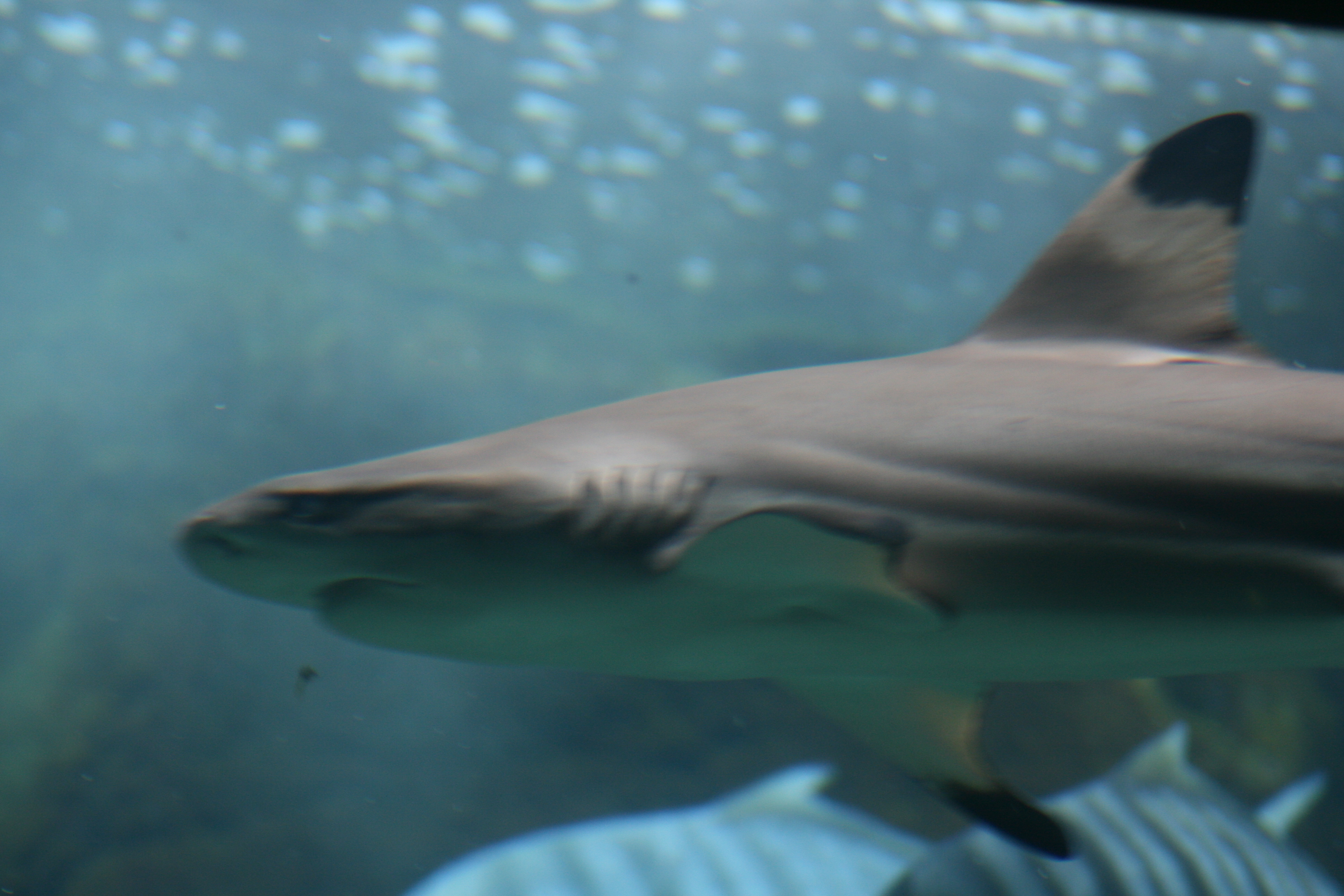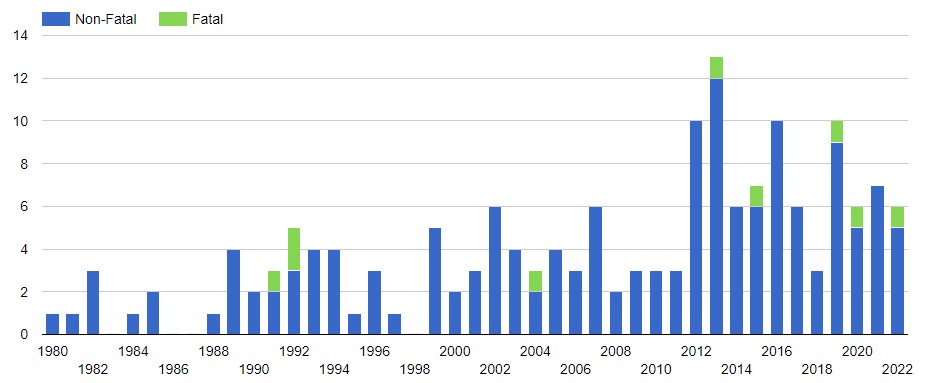Sharks in Hawaii keep some people out of the water.
They can scare people to the core. Galeophobia is the fear of sharks and most of us have it to some degree. JAWS, the movie, sure didn’t help people get over that fear, and this article will likely only exacerbate whatever fear you have in your own head about sharks in Hawaii, though I can assure you, my intention is to help you get a more realistic picture of the shark situation around the Hawaiian Islands.
HAWAII SHARK BASICS

Blacktip Reef Shark at the Georgia Aquarium by Andrew Kalat is licensed under CC BY-ND 2.0. Image may have been resized or cropped from original.
Sharks are top-level vertebrate predators that fear nothing and eat whatever they can catch. The average shark life expectancy is of between 20 and 30 years, depending on the species. A few species like the Great White and Tiger sharks in Hawaii can grow to over 20 feet long, are heavy, and have a large turning radius so they would have trouble catching their usual prey if they didn’t have some great sensory organs to help them find prey. Sharks have no problem finding things to eat, even in total darkness or muddy water. If it’s dark, the shark has cat-like eyes which clarify the image. It’s actually a row of small reflective plates that redirect the light through the retina a second time that allows sharks to see their prey even in the extreme light-deficient depths of the ocean.
A shark’s sense of smell is fine-tuned for blood. Sharks can sense one particle of blood in a million. It can track the blood through the water to the source in a short time, in part because the shark can distinguish the strength of the smell in each nostril and turn toward where the scent is strongest. This is one reason nobody with an open wound or females during menstruation should enter the ocean where sharks could be lurking.
So many things give the shark the extra edge in hunting prey: lateral line, smell, sight, hearing, and ampullae of Lorenzini.
Special Sense Organs of Sharks
Ampullae of Lorenzini – This specialized organ gives the shark a sort of 6th sense, giving it the ability to detect electromagnetic fields as well as temperature gradients. Sharks could possibly be more sensitive to electric fields than any other animal. With a centimeter-long ampulla, they can sense 5 one billionths of a volt of electricity. That is approximately 5 million times stronger than what humans can sense.
Lateral Line – these receptors in this organ help the shark sense movement of water, and vibrations in the water. Using the lateral line, a shark can feel movement in the water surrounding it up to 330 feet away.
Sharks are fast enough to catch a lot of different prey. Great White sharks can reach a swim speed of 50 kilometers per hour (30 miles per hour), when preparing an attack, though most sharks max out around 12 mph.
WHAT KIND OF SHARKS LIVE IN HAWAII?
There are 41 distinct species of shark in Hawaii’s warm Pacific Ocean. As far as we know, these are the most dangerous: Tiger Sharks (Galeocerdo cuvier); Great White Sharks (Carcharodon carcharias); Galapagos Sharks (Carcharhinus galapagensis); Bull Sharks (Carcharhinus leucas); Mako Sharks (Isurus oxyrinchus; Isurus paucus); and Hammerhead Sharks (Sphyrna zygaena; Sphyrna lewini). Of the other 35 species, most are smaller reef sharks, and some have bitten people, but those mentioned above are ones to be concerned with in Hawaii. Identification of a shark as one of the less harmful species does not mean you should fail to take it seriously when in the water. Do be careful with every shark, they all have large mouths, many teeth, and can cause significant wound damage with a bite.
The most frequently encountered Hawaiian reef sharks?
The White Tipped Reef Shark, Scalloped Hammerhead Shark, Tiger Shark, Galapagos Shark, Gray Reef Shark, and the Sandbar Shark. The Tiger Shark and the Galapagos Shark are the most aggressive of the Hawaiian reef sharks. The other known Hawaii sharks don’t typically attack for any reason, but when provoked or when blood is in the water from spear-fishing, anything goes. Hawaii reef sharks can be aggressive, but they usually need blood in the water to become dangerous.
WHAT DO SHARKS EAT?
The typical shark diet includes fish, turtles, squid, sea snakes, rays, Hawaiian monk seals, and dolphins. Occasionally they’ll eat birds, dogs, trash, pieces of boat, human beings, and even each other.
Sharks are more active for hunting during the time right before sunset and sunrise, and night. They prefer murky unclear water because they can use their ampullae of Lorenzini organs to sense the electrical fields in their prey and attack them easily, though they cannot see it. In turn, sharks can be invisible to their prey, a good thing when they are a couple of meters long and hundreds of pounds. Their size makes them easy to see and avoid for prey in the clear water.
Sharks typically hunt for fish, turtles, dolphins and seals during the low light times of dusk and dawn. Sharks can detect the faint electrical fields given off by all living organisms, and even by the magnetic field of the earth! As they recon the water, receptors on the sharks’ snouts allow them to locate their prey without seeing it.
SHARKS IN OLD HAWAII
Hawaiians called the god of the sharks, Kauhuhu. They have many stories about sharks they have passed down through generations. The Hawaiian word for shark is, mano.
The Shark-Man, Nanaue, by E.M. Nakuina
WHY DO SHARKS ATTACK PEOPLE IN HAWAII?
The experts say sharks attack people as a case of mistaken identity. I take issue with this. After thousands of shark attacks worldwide, some in which the sharks consume some or most of bodies of the victim, I have to disagree with that statement. Sometimes sharks know what you are, and know they can eat you, and do. There are enough people in the water that sharks know what we are. We are a food source. We may not be a preferred food source, but, over countless millenia, anything soft enough that enters the ocean, is eaten by sharks. They don’t care all that much what it is. They are opportunistic feeders. They eat what is present. If you are present, they will eat you if they are hungry. It isn’t personal. It’s ridiculous to say that all cases of shark attack are misidentification. Sharks have sensory organs that enable them to sense the electrical fields of animals. They have eyes. They have lateral lines. They know what turtles move like in and on top of the water. They know how seals move. They know what fish look like. They know what humans look like.

Shark by Ben Loomis is licensed under CC BY 2.0. Image may have been resized or cropped from original.
Sharks attack people for many reasons. Primarily, they have either decided a human in the water is a valid food source, or, is a potential food source, and give a little nip before deciding. Many times sharks decide they don’t want to eat a person, and they don’t finish the job. Other times, sharks eat the entire person. It’s not mistaken identity at that point. They know it isn’t a seal or turtle. They eat it anyway. If you have a look at that Wiki article about shark attacks in the USA – you’ll get the idea real fast that sharks eat humans often. Keep in mind, that is just attacks in the USA. There are another hundred or so nations with borders on an ocean with sharks. There are thousands of documented attacks worldwide, and some are scarier than any movie depiction.
HOW MANY SHARK ATTACKS IN HAWAII YEARLY?
There are usually three to four shark attacks in Hawaii per year and usually no fatalities result. However, just recently a German tourist lost her arm, and just today she died in intensive care at Maui Memorial Medical Center after being treated for a week. She was bitten while snorkeling off Maui at Hamoa Beach. Most attacks involve arms or legs and there is no further bite after the first one. The last fatal attack in Hawaii before this was in 2004.
I created a Google Docs spreadsheet called, Hawaii Shark Attacks, covering the years 2001 to 2013, to see if it would help me get a better idea of the reality of shark attacks in Hawaii. What I found was surprising.
Shark Incidents by Year
I was also interested in what time of day sharks attack most often, so I could ascertain if there was a time of day worth avoiding. Sharks appear to be consistently on the hunt from 0600 to 1800. The numbers of attacks are fairly constant. The lull around 8 am. to 10 am. might be because few people are in the water during that time. The 6 am. to 8 am. time period has a lot of regulars on “Dawn Patrol” – surfers that meet every morning before work when the crowds are non-existent. Here’s a look at the number of attacks during each two-hour period in military time (0600 is 6 am. on the 12-hour clock):
- 0600-0800 – 12 attacks
- 0801-1000 – 6
- 1001-1200 – 12
- 1201-1400 – 13
- 1401-1600 – 10
- 1601-1800 – 10
Does the clarity of the water have any bearing on the attacks in Hawaii? It seems to. Out of 63 attacks over the past almost thirteen years, there were attacks during clear water – 26 times. Seems like sharks bite whenever they are hungry, regardless of water clarity. They might prefer sandy, turbid, muddy water by a 2-to-1 margin, but, they bite plenty of times when the water is clear.
In the last almost 200 years, there have been 8 deaths attributed to sharks around the Hawaiian islands. But there have also been numerous events where people have been lost at sea while swimming or surfing, boating, where a shark attack was non-conclusive. Some of these are likely shark attacks and involved fatalities. There have been over 116 attacks during this time period. So, roughly one out of twenty attacks has resulted in human death.
Thirty four of the shark attacks in the islands were either identified as tiger sharks by witnesses or victims, or the conclusion was drawn after examining evidence post-attack.
Researching further, I found the Wikipedia entry for shark attacks in the United States. If you are an avid surfer, snorkeler, diver, spearfisher, or anybody that gets in the ocean around Hawaii for any reason, I have to caution you before you read the descriptions of attacks at this link. I just spent twenty minutes reading it and soaking it all in, and I don’t know whether I’ll ever ride a surfboard again. Some of the attacks are just mind-numbing. Here’s the link. I’m not joking when I caution you not to read this page if you want to continue spending time in the water, because some of you might change your mind after reading this: Wiki Shark Attacks in USA.
WATER PRECAUTIONS
It isn’t all bad though. There are many things you can do to avoid shark encounters, or at least lessen the probability of being attacked by one. Here are some of the most highly recommended tips by experts.
1. Avoid murky water. When it rains, the run off of freshwater over the land and into the ocean creates a very murky marine environment which sharks love. They love it because their prey cannot see them before they attack, so they can eat as much as they want. They sense their prey using the electric impulses all living creatures emit. If you look at my spreadsheet you’ll see that about 2/3’s of attacks occurred in turbid water (crashing waves usually), the water is not clear because of bubbles and sand being stirred up.
2. Do not enter the water when bleeding, however slight.
3. Avoid spearfishing, which puts significant amounts of blood in the water. If spearfishing, don’t attach your fish to a stringer and then attach it to your body, and change your location often.
4. Avoid swimming near someone netting, or using chum for fishing.
5. Use low contrast colors and patterns. It’s like fishing, you don’t fish with camouflage lures, you fish with high-contrast colors and patterns so the fish can see it and attack it. Well, with sharks you want to be as invisible as possible. Choose low contrast clothes, scuba equipment, and surfboards. Remember, it’s the bottom of the board the shark can see, not the top. Dark blue surf or diving gear is probably best.
6. Don’t enter the water alone.
7. Don’t swim or surf too far from shore.
8. Don’t enter the water at night.
9. Be alert for signs from other animals that may signal sharks nearby. Dolphins in close to shore, baitfish jumping out of the water, etc.
10. Avoid swimming close to the mouths of rivers or streams where they empty into the ocean.
11. Avoid swimming or surfing near jetties, piers or other structures in the water. Sharks often feed at such places.
12. Avoid loud splashing, hard physical splashing, jumping straight into an area that might have sharks. All these activities attract sharks. Don’t swim with dogs, horses, or other animals, their movements may attract a predator.
ANTI-SHARK SYSTEMS (DETERRENTS)
There have been various inventions that are said to reduce shark attacks by repelling them with electronic pulses, scents, and sounds. Over the years I’ve seen very, very few people ever surfing with one of these contraptions. I don’t know why surfers are so against them. Personally, I’d use it every time I went out, if I knew it would work.
Here’s a wearable shark repellent system for around $600 at Amazon.com. It looks a little clumsy to wear while surfing, but still – the benefit probably outweighs the dork factor, I’d think. Seachange Shark Shield

Tiger Shark by 35079252@N00 is licensed under CC BY-NC-ND 2.0. Image may have been resized or cropped from original.
The devices work by causing discomfort to the sharks through their ampullae of Lorenzini – as I mentioned earlier, it’s the electrical sensing organ sharks use to size up prey. This seems like the best way to go about it. I saw a photo of a guy on a boat putting the palm of his hand on the nose of a large shark, which is said to short-out the shark’s brain for a bit because there is too much stimulation coming through the ampullae of Lorenzini. If sharks can detect these very faint electrical impulses, then blasting them with some strong signals that overwhelms them seems like a great strategy. Some devices can be placed in the leash for your board, or on the board itself.
Vern’s Comments
The owner of one of the companies I worked for on Oahu told me about a weekend trip to Waimea Bay on the North Shore of Oahu one time. He and his family were all sitting there eating food at a picnic, when all the sudden about 40 meters away from the beach a giant tiger shark jumped out of the water, high in the air, and had a dolphin (like flipper, not mahi-mahi), in its mouth. It then tore the dolphin apart in front of a hundred or so onlookers.
Welcome to the real world kids, pull up a chair, grab yourself a chicken leg and watch the show – right?
My shark story happened when I was living in Clearwater, Florida. I would go wade fishing in water up to my chest. I was catching big gator trout one morning and I had three of them on a long stringer that I had wrapped around my girlfriend’s neck. As you can see, I gave no thought to sharks at that time. Within ten minutes of moving the stringer from my neck to hers, she flew into the back of me, almost knocking me down, at the very same time I felt a massive shark bump against my thigh as it passed. It had apparently grabbed the trout on the stringer and was heading for deep water. My girlfriend was trying to tell me she was being pulled by the stringer around her neck, but we couldn’t talk or anything, it happened so fast. Eventually I was able to slip the stringer over her head and pull her back to shore. She was really shaken up and refused to get in the water again that day, and she refused to go fishing with me ever again. Go figure, right?!
I’ve seen it stated a couple of times that the odds of being attacked by a shark in the United States is about 1 in 6 Million. If you live in Hawaii and spend time in the water every day, I’m going to say that the odds increase considerably, and not in your favor. Most people never see a shark while surfing, or swimming. I saw shark fins while surfing twice in Hawaii. They were very small, and I wasn’t really afraid at all at the time. Usually a shark attack isn’t preceded by a fin you can see coming at you like it is in the movies. Yearly in Hawaii there are an average of three to four shark attacks in the waters around the islands. In 2012 there were eleven attacks. In 2013 already we have had eight, four in Maui alone, and we’re only in the latter half of August.
I’ve swam and surfed at many of the spots listed on my spreadsheet where people have been attacked by sharks. Kihei, Ka’anapali, Sunset Beach, Makena, Baldwin Beach, Ewa Beach, Nimitz, Bellows AFS, Velzyland, Honokowai, Sandy’s, Kapalua, and these are just beaches where attacks have taken place over the past 12 years. Kihei and Ka’anapali, Honokowai areas seem to be a couple of hotspots that I’ll likely avoid in the future. However, Makapu’u on Oahu still looks good!
Ok, that wraps it up. Have a look at my Hawaii Shark Attacks Spreadsheet if you haven’t already. If you have a shark story, I’d love to hear it in the comments!
This article was written by Vern Lovic and the opinions are his own
2012 Summary of Shark Attacks globally.



